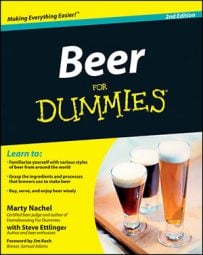In order to fully understand and appreciate the various beer styles that exist in the world, knowing how beer styles differ from one another and how those differences are measured is helpful.
Defining beer styles with three parameters
All beer styles can be easily identified and differentiated by three simple measurements:
Color: All beers have color, whether it’s light, dark, or somewhere in between. The color of beer is determined primarily by the grain used to make the beer. Light-colored grain results in a pale-colored beer; conversely, darker-roasted grains produce darker beers.
The spectrum of beer color ranges from straw to black, and this color range is measurable on the Standard Reference Method (SRM) scale (0 to 50). (You don’t necessarily need to know the details behind the Standard Reference Method, just that the numbers on this scale correlate to color; low numbers represent paler beer, high numbers represent darker beer.)
Bitterness: All beers have some level of bitterness. Bitterness in beer is primarily the result of extracting alpha acids from hops during the boiling process.
Hop bitterness is measured in International Bittering Units (IBUs). An American Light Lager may have 5 to 8 IBUs, while an Imperial India Pale Ale (IPA) may have 100 or more IBUs.
Gravity: All beers have some level of viscosity, whether it’s dense or watery. The term gravity refers to the density of beer. Gravity is measured on the day the beer is brewed and is determined by the amount of soluble sugars — known as maltose — dissolved in the beer.
Gravity can be measured on the specific (or original) gravity scale (1.000 to 1.150) or the Balling Scale (0 to 40); these scales are like the Fahrenheit and Celsius scales of the beer world.
Because maltose is consumed by yeast during fermentation, the gravity of the beer lowers to about 20 to 25 percent of its original level by the time it’s ready for packaging.
Keep in mind, all these numbers can tell you a lot about how the beer looks and tastes, but the yeast still determines whether the beer’s an ale or a lager.
Using a few tasting terms
You need to know at least the following tasting terms to understand basic beer styles. Knowing these terms may also encourage you to explore and experiment (and also give you something to talk about with any hophead you may encounter at the bar):
Aggressive: As you may expect, an aggressive beer has a boldly assertive aroma and/or taste.
*Balanced: Balanced simply means that the malt and hops are in similar proportions, and the flavor has an equal representation of malt sweetness and hop bitterness — especially at the finish.
Body: The body is the sensation of fullness, or viscosity, of a beer on the palate, ranging from watery to creamy. Beer is generally described as thin-, light-, medium-, or full-bodied (strong simply refers to alcohol content).
Complex: Complex means the beer is multidimensional, involving many flavors and sensations on the palate (the opposite of simple).
Crisp: Crisp means the beer is highly carbonated or effervescent. Beers regarded as crisp are typically on the drier side as well.
*Diacetyl: This term describes a buttery or butterscotchy aroma or flavor.
Estery: Estery is full of aromas that are reminiscent of fruits.
Floral: Floral is full of aromas that are reminiscent of flowers.
Fruity: Fruity means the beer has flavors reminiscent of various fruits.
Hoppy: Hoppy means the hops have earthy, herbal, spicy, or citrusy aromas and flavors.
Malty: Malty describes flavors derived from malted grain. Malty beers have a more pronounced malt richness and sweetness.
Mouthfeel: Mouthfeel is the tactile sensations of alcoholic warmth, carbonation, dryness, and the like. Body is also part of mouthfeel.
Roasty/toasty: Roasty/toasty describes the malt (roasted grain) flavors.
Robust: Robust describes a rich and full-bodied beer.

